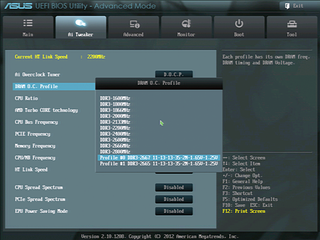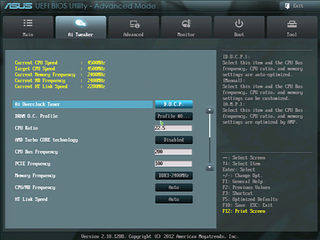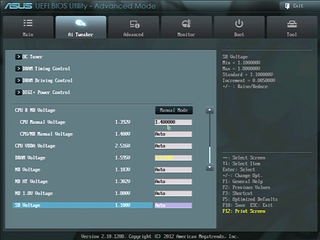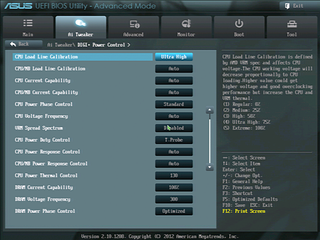Three AMD 990FX-Based Motherboards For Enthusiasts
AMD’s flagship FX-series processors squarely target enthusiasts with sub-$1,000 system budgets, and it's hard to get there with an expensive motherboard. We requested every vendor's top-value solution, and received three boards for your consideration.
M5A99FX Pro R2.0 Firmware
Asus DRAM O.C. Profile adds Intel XMP configurations and several of Asus’ own custom memory overclocking settings to AMD-based motherboards. It’s found alongside other overclocking controls in the M5A99FX Pro R2.0’s Ai Tweaker menu.

A 4.51 GHz overclock was easily achieved at 1.40 V using a 22.5x CPU multiplier and Asus’ mildly-overclocked 200 MHz reference clock. Our DDR3-2666 samples climbed to a 2625 MHz data rate using even higher base clocks, but lower CPU multipliers were needed to get there.

The 1.40 V CPU core setting appeared accurate, but the 1.65 V memory setting did not. Our volt meter showed that 1.65 actual volts resulted from a 1.61 V setting, in spite of the motherboard’s insistence that only 1.595 V was detected. Misreporting DRAM voltages to achieve higher overclocking results has become universal among all recently-reviewed enthusiast motherboard brands.

A CPU Load Line Calibration setting of “Ultra High” is supposed to correspond to 75% correction, but kept our CPU core voltage 100% consistent under changing loads.

The M5A99FX Pro R2.0 shows current timings next to each adjustment, with Auto defaults for each selection. Users configuring custom timings can use the current timings columns to guide their efforts, which in our case began with the memory’s XMP profile.



Stay on the Cutting Edge
Join the experts who read Tom's Hardware for the inside track on enthusiast PC tech news — and have for over 25 years. We'll send breaking news and in-depth reviews of CPUs, GPUs, AI, maker hardware and more straight to your inbox.
Current page: M5A99FX Pro R2.0 Firmware
Prev Page M5A99FX Pro R2.0 Software Next Page Gigabyte 990FXA-UD3-
designasaurus "if we diminished most of those power differences by not installing Asus' power management software at default settings, the company would have likely matched the performance of Gigabyte and ASRock."Reply
Don't speculate! Do the tests and add it to the article so we can see what the software packages are actually accomplishing! That's why I read your site, yeah? For hard info that I can't get myself. -
bgunner designasaurus"if we diminished most of those power differences by not installing Asus' power management software at default settings, the company would have likely matched the performance of Gigabyte and ASRock."Don't speculate! Do the tests and add it to the article so we can see what the software packages are actually accomplishing! That's why I read your site, yeah? For hard info that I can't get myself.I totally agree with this statement. The test should have been done and added into the article because this would of been a good representative of the value of the software. I would like to know for a fact if the software was a hindrance to the electrical efficiency of the Asus and Gigabye boards.Reply -
Crashman bgunnerI totally agree with this statement. The test should have been done and added into the article because this would of been a good representative of the value of the software. I would like to know for a fact if the software was a hindrance to the electrical efficiency of the Asus and Gigabye boards.At least the power was measured and mentioned, even if it didn't get into the chart.Reply
-
bit_user AMD's 890FX was an excellent low-cost server platform, in its day. Great I/O, tons of PCIe lanes, 6-channel SATA3, and ECC support. All with boards and CPUs in the desktop price range that were close to being performance competitive with Intel (when they were introduced, at least).Reply
Now, AMD is just slipping too far behind. Not just on the CPU front, but like how about some PCIe 3?
I'm waiting for 64-bit ARMs to hit the desktop. That's probably the next truly interesting thing on the horizon.
-
boulbox Reply10596062 said:Aren't the 990FX chipsets kind old?
Yes, but not a lot of new things need to be offered anyways. PCIe 3.0 is just a gimmick and doesn't really give much more performance over PCIe2 -
Crashman falchardAren't the 990FX chipsets kind old?990FX is AMD's current "high-end" chipset for enthusiast-level desktops. AMD occasionally releases new chips (look last fall) and motherboard companies keep updating their selection of products.Reply
Old chipset, recent boards, any questions?
-
darkchazz "Three AMD 990FX-Based Motherboards For Enthusiasts"Reply
I don't think enthusiasts would want to buy a slow CPU from AMD. -
Onus What did I miss? The ASRock has better features, including 3-way SLI, more USB3.0, an abundance of accessories, uses less power (the only positive efficiency), has higher performance, lower VRM temps; but BOTH of the other two got awards? I noted the comment about fluctuating prices, but on features alone ASRock looks like the winner. Surely it wasn't the slightly lower OC...Reply

